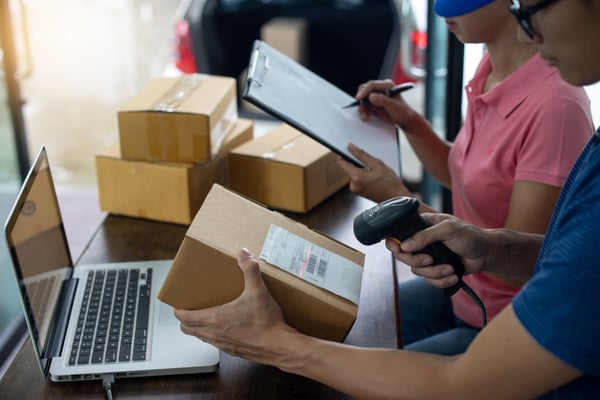Parcel Post & Last Mile Logistics: E-commerce Series (Part 4)

The companies that provide last-mile delivery services to the e-commerce world are masters of supply chain efficiency – most of the time. Part 4 of our E-commerce Series provides an overview of how 3PL providers are evolving to keep up with the surge in consumerism brought to us by e-commerce movements like the 'Amazon effect'.
Parcel delivery
Parcel delivery is intensely competitive, expensive and error-prone. When it's done well customers are happy because they've received the service level promised by the online retailer. But when it goes wrong, everybody has mud on their face – the retailer looks bad, and the delivery service looks incompetent.
The pressure to succeed is enormous, and the volume of parcels is mind-boggling. In 2017, 8.95 billion parcels were delivered globally at an average cost of US$6.4 per cubic meter[1]. Amazon alone shipped more than five billion items worldwide, blowing its 2016 one-billion record out of the water[2]. Largely thanks to Amazon, two-thirds of retailers expect their last-mile partners to offer next day delivery[3]. In order to accomplish this, delivery services must leverage the latest in technology for receiving, sorting, routing and tracking.
Conquering the last mile
The last mile is widely considered a massive logistics challenge and is potentially the weak link that may spell trouble as e-commerce continues its exponential growth[4]. As solutions like drones, autonomous vehicles, pick-up in store and crowd-sourced deliveries are all under development, existing delivery firms can work with the transportation and distribution assets they currently own by implementing better technological oversight systems. But they can be hampered when different parts of the business don't talk to each other.
Canada Post offers a good example in its recent past, when it invested billions in modernization[5], a large portion of which went to automated sorting technology to improve the flow through its distribution centers. Unfortunately, the plan failed to take into account the growing traffic in its truck yards, and the time spent trying to locate trailers effectively canceled out the gains made from the fancy new sortation technology. To the credit of Canada Post, they have subsequently addressed these issues by implementing a best of breed yard management solution throughout their enterprise.
This is an important piece of the puzzle for parcel delivery because the investment in technology is so great that it must be made to work to its full capacity.
One solution is to introduce a control tower system, which gives visibility into operations across departments, over multiple sites and with many thousands of pieces of equipment. C3 Solutions integrated its YMS into such a system for a large UK parcel delivery company (read our case study here). The result was full visibility into a fleet with more than 600 tractors and 1,500 trailers, and the ability to almost eliminate idle time for trailers in the company's four facilities' yards. Until alternative solutions are found for last-mile delivery, the parcel delivery companies will continue to face the challenge of operating at peak speed and efficiency. Achieving peak speed means ensuring that trailers are processed without delays. This means they need to be able to know where trailers are for drivers to pick them up without wasting time searching. It means they need to be able to see when a yard is reaching capacity and act to prevent bottlenecks that slow operations down.
In the parcel delivery business, the ability to leverage technology like YMS outside the facility in conjunction with the most advanced sortation technologies inside the facility is a key competitive advantage that is critical for success in the e-commerce marketplace.

Reverse logistics
Until e-commerce came along, returns or reverse logistics was usually an afterthought. But now, with online shoppers returning about 13 percent of purchases, and almost 40 percent of e-commerce customers believing it's important to have free return shipping when ordering something online[6], retailers need a returns strategy that works.
And it's set to get harder. Up to 25 percent of fashion retailers around the world will be implementing try-before-you-buy (TBYB) services by 2019, where customers can return items after a 30-day trial period. Recent research by BrightPearl shows this trend may result in a quadrupling of return costs for US retailers[7]. In 2017, U.S. return delivery costs amounted to US$381 billion and are expected to reach US$550 billion by 2020[8].
Once items come back, retailers then have to figure out what to do with them. Returned inventory is not welcome back on the docks; where it sits until staff figures out what to do with it. “It creates a burden on your day to day warehousing function,” said Eian Campbell, director of operations at Danby products[9]. And putting undamaged items back on the shelf for resale costs twice as much as selling them in the first place[10].
According to the BrightPearl study, 44 percent of retailers say their margins are "strongly impacted" by handling returns, while 66 percent are not using technology to manage them.
An argument for technology
 A majority of online retailers recognize that it makes financial sense to outsource returns[11], but 54 percent in a recent survey claim they want to keep it in-house to maintain control[12]. Whether your company decides to do it yourself, or outsource, you cannot simply put the outbound process in reverse and expect it to work. There are so many variables introduced in the retail returns process, from the unpredictable way items are packaged by customers that affects freight rates (thanks to cube dimensions), and can even damage goods that were fine before they were sent back, to the need to examine and expertly assess every single item to determine its appropriate stream – restock, discount or trash.
A majority of online retailers recognize that it makes financial sense to outsource returns[11], but 54 percent in a recent survey claim they want to keep it in-house to maintain control[12]. Whether your company decides to do it yourself, or outsource, you cannot simply put the outbound process in reverse and expect it to work. There are so many variables introduced in the retail returns process, from the unpredictable way items are packaged by customers that affects freight rates (thanks to cube dimensions), and can even damage goods that were fine before they were sent back, to the need to examine and expertly assess every single item to determine its appropriate stream – restock, discount or trash.
Managing all these processes is a complex task, and is usually the responsibility of many different departments – transportation, inventory control, purchasing, AR, etc. So whether it's in-house or done by a third-party supplier, the returns process needs to rely on strong interdepartmental communications and technological interface. That's where systems such as the control tower used by the UK parcel delivery firm are vital. Real-time data sharing, electronic documents, and flow control are essential to managing the variables and complexity in returns. Keeping track of returns and the value they represent for the supply chain is a critical operational concern that can be solved through the use of appropriate technologies.
REFERENCES:
[1] "Last-mile delivery – Statistics & Facts", Statista, 2018.
[2] "Solving for the last mile is retail's next big disruption", Lara Ewen, Retail Dive, February 27, 2018.
[3] "Which services are you looking for from your last mile partner(s)", Statista, 2018.
[4] "Solving for the last mile is retail's next big disruption", Lara Ewen, Retail Dive, February 27, 2018.
[5] "With mail dying, Canada Post bets its future on e-commerce", Paul Christopher Webster, The Globe & Mail, May 12, 2018.
[6] "Most important return policy characteristics for online purchases in 2016", Statista, 2018.
[7] "Try-before-you-buy trend is causing 'returns tsunami'", Derek O'Carroll, BrightPearl, April 30, 2018.
[8] "Costs of return deliveries in the United States from 2016 to 2020", Statista, 2018.
[9] "Build a returns strategy to prevent erosion of profit", Emily Atkins, Inside Logistics, November 9, 2017.
[10] "Tis the season...for holiday returns", Retail Dive, October 9, 2018.
[11] "Why are your outsourcing or planning to outsource your reverse logistics task?", Statista, 2018.
[12] "Why are you/will you be handling your reverse logistics tasks in-house?", Statista, 2018.

